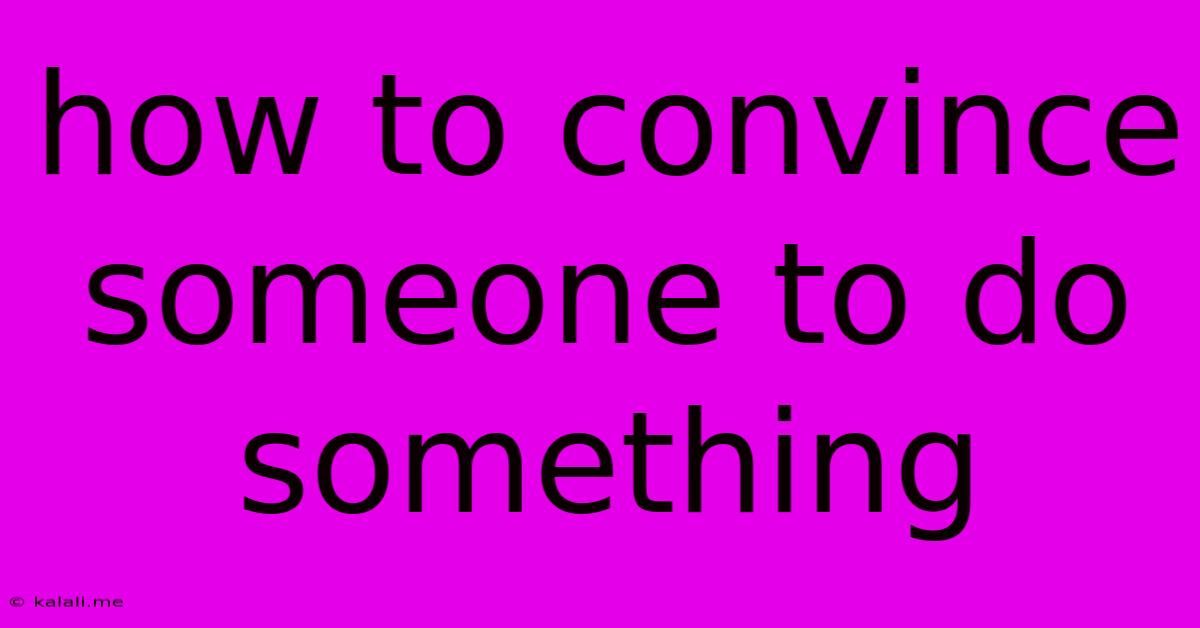How To Convince Someone To Do Something
Kalali
May 31, 2025 · 3 min read

Table of Contents
How to Convince Someone to Do Something: Mastering the Art of Persuasion
Meta Description: Learn powerful persuasion techniques to influence others positively. This guide explores effective communication strategies, building rapport, and understanding motivations to convince someone to take action.
Convincing someone to do something isn't about manipulation; it's about effective communication and understanding their perspective. Whether you're trying to persuade a colleague to adopt a new strategy, a friend to try a new restaurant, or a family member to consider a different viewpoint, the principles remain the same. This article will equip you with the tools to navigate these situations with grace and achieve your desired outcome.
Understanding Your Audience: The Foundation of Persuasion
Before you even begin to articulate your request, you need to understand the person you're trying to convince. What are their values? What are their goals? What are their concerns? By understanding their motivations, you can tailor your approach to resonate with them on a personal level. This involves active listening – truly hearing their perspective, not just waiting for your turn to speak. Ask clarifying questions, show genuine interest, and demonstrate empathy for their point of view.
- Identify their needs and desires: What are they hoping to achieve? How can your proposal help them reach those goals?
- Recognize their potential objections: What are the likely downsides or challenges they might foresee? Addressing these concerns proactively will strengthen your argument.
- Emphasize shared values: Find common ground and frame your request in terms of values you both hold dear.
Crafting Your Message: The Power of Persuasive Communication
Once you understand your audience, you need to craft a message that is persuasive and compelling. This involves:
- Clear and concise language: Avoid jargon and technical terms they might not understand. Use simple, straightforward language to get your point across.
- Strong evidence and examples: Back up your claims with solid evidence, statistics, and real-world examples. Anecdotes can be especially effective in building connection.
- Positive framing: Focus on the benefits of your proposal, rather than dwelling on the negatives. Highlight the positive outcomes and opportunities.
- Storytelling: People are drawn to stories. Weaving a narrative around your request can make it more engaging and memorable.
- Building rapport: Establishing a connection before making your request is crucial. Find common interests, share relevant experiences, and build trust.
Techniques for Effective Persuasion
Several techniques can enhance your persuasive abilities:
- The reciprocity principle: Offering something first, like a favor or a helpful suggestion, increases the likelihood that the other person will reciprocate.
- The scarcity principle: Highlighting the limited availability of something can make it seem more desirable.
- The authority principle: Presenting yourself as knowledgeable and credible will lend weight to your argument.
- The consistency principle: Appealing to their past behaviors or statements can make them more likely to agree with your request.
- The social proof principle: Mentioning how others have successfully done what you're suggesting can be very influential.
Handling Objections and Resistance
Not everyone will immediately agree with you. Be prepared to address objections and handle resistance with grace and patience:
- Listen actively and empathetically: Show that you understand their concerns.
- Acknowledge their perspective: Don't dismiss their objections outright.
- Reframe your argument: Address their concerns directly and present your proposal in a new light.
- Offer compromises: Be willing to negotiate and find a solution that works for both of you.
Convincing someone to do something is a skill that takes practice and refinement. By understanding your audience, crafting a compelling message, and employing effective persuasion techniques, you can significantly improve your ability to influence others positively and achieve your goals. Remember, genuine connection and empathy are always the most effective tools in your arsenal.
Latest Posts
Latest Posts
-
Electric Field On Surface Of Conductor
Jun 02, 2025
-
Relative Extrema A Nth Degree Polynomial
Jun 02, 2025
-
How Long Does It Take For Loctite To Dry
Jun 02, 2025
-
Mold Or Mildew On Bathroom Ceiling
Jun 02, 2025
-
Subquery With More Than One Column Returned
Jun 02, 2025
Related Post
Thank you for visiting our website which covers about How To Convince Someone To Do Something . We hope the information provided has been useful to you. Feel free to contact us if you have any questions or need further assistance. See you next time and don't miss to bookmark.